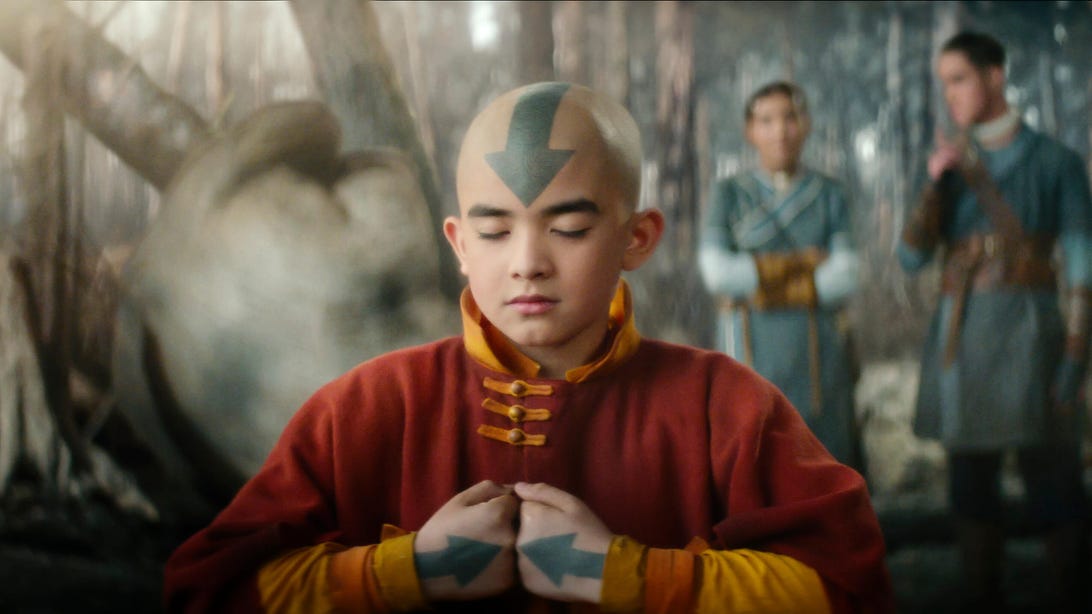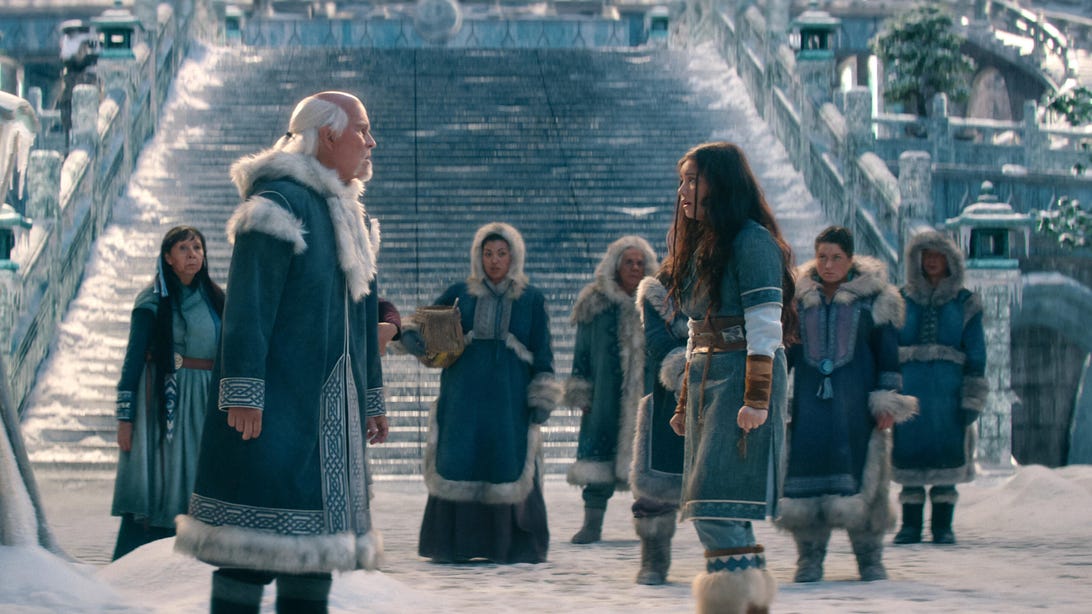Join or Sign In
Sign in to customize your TV listings
By joining TV Guide, you agree to our Terms of Use and acknowledge the data practices in our Privacy Policy.
Netflix's Avatar: The Last Airbender Boss Addresses Sokka's Sexism: 'It Wasn't Necessarily Removed'
Albert Kim also talked about Sozin's Comet and what he had envisioned as a post-credits scene

Gordon Cormier, Avatar: The Last Airbender
Netflix[Warning: The following contains spoilers for Netflix's Avatar: The Last Airbender. Read at your own risk!]
At last, Netflix's Avatar: The Last Airbender — a project first announced in 2018 — is here. In the weeks leading up to the premiere of the live-action series based on Nickelodeon's beloved animated show, fans of the original title swarmed the Internet with reactions to everything from teaser clips to interviews with the cast and crew. It's something that showrunner Albert Kim is very aware of, though he has tried to be "a little bit judicious" in how much he follows the online chatter.
"I've seen some of the reactions on social media — at the same time I know that's not the best for my mental health," Kim told TV Guide a day before the Netflix drama's release. "Up 'til now, I have also been telling myself, a lot of these early reactions have been without the benefit of having seen the show." His suggestion to fans has been simple: "Wait until the show comes out, and watch it and then you can have the discussion."
All 8 episodes of Netflix's Avatar: The Last Airbender are now available, and there's plenty to dissect. The show stars Gordon Cormier as Aang — the titular avatar tasked with saving the world from the Fire Nation's destruction led by Ozai (Daniel Dae Kim) — Kiawentiio as Katara, Ian Ousley as Sokka, and Dallas Liu as Zuko.
Ahead of Avatar's premiere, we asked Kim about the final scenes of the live-action series, the potential of future seasons, this rendition of Sokka, and how sexism is portrayed in the show.
Netflix's Avatar: The Last Airbender: Cast, Release Date, and Everything to Know
TV Guide: I want to ask about the very end of the season. The final scene is between Fire Lord Ozai and the Great Sage talking about the return of Sozin's Comet, which appears mostly in Book 3's events in the original series. How did the decision come about to end the season with that scene?
Albert Kim: As all the diehard fans know, Sozin's Comet is kind of the ticking clock of the original series. That's the point at which Aang and our heroes have to essentially confront the Fire Lord before that comet returns, because all the Firebenders will be enhanced by the power of the comet, which we see in the very first scene of the season. That sets the stage for the show. We had a little bit of a logistical issue in that the original series takes place — all three seasons take place — within the span of a calendar year. But we were never going to be able to do that because our actors actually age and grow up. So we knew we were going to have to account for a slightly longer time period, which is why we didn't introduce the comet in the course of the season and say it's definitely coming back in a month, a year, or however long. We set it up almost like a little bit of an Easter egg at the very end, saying, "Sozin's Comet is coming back." That is the threat. But we don't give a specific timeframe to it.
Given that the first scene shows Sozin's Comet, did you know from the start that you would end the season with the mention of it?
Kim: I don't think that final scene was in mind from the beginning, it came about a little bit later. In fact, I always intended it to be one of those Marvel after-credits scenes. If you saw it, cool. If you didn't, it didn't detract from your sense of the story. But Netflix as a streaming platform has some restrictions on where you can put a scene like that before the "Next Episode" button comes up. So we had to put it a little bit closer. For me the true ending of the story is really with Azula conquering Omashu. To me, the bookends of the season were Fire Lord Sozin's attack on the Southern Air Temple, which was a result of misdirection: He tells the world he's going after the Earth Kingdom, and instead he goes after the Southern Air Temple. And then the same thing happens at the end of our season, which is Fire Lord Ozai uses misdirection to conquer Omashu. To me, those were the bookends of the season.
I know there are no decisions shared about renewals yet. But if the show is renewed, would you envision it to have three seasons similar to the three books in the original? Or a different number?
Kim: The focus has been on getting Season 1 across the finish line, so there haven't been any decisions [made]. I will say we have the benefit of hindsight. We know where the original series goes, so we have a roadmap on how to get there. Whether or not that breaks into two seasons, three seasons, that has not been brought up. I get a little superstitious talking about stuff that we don't know yet, I want to make sure that this first season is a huge hit so that we can have those discussions.
Something else I wanted to ask about are the changes made to Sokka's character. Ian Ousley and Kiawentiio said [in an interview with Entertainment Weekly] the show was taking out Sokka's sexism, and some fans responded saying that his sexism was an integral part of his character development in the original series. With that element mostly gone, where do you think Sokka's character development comes from the most throughout the Netflix show?
Kim: That was a comment that was, if not taken out of context, it was taken without the context of the episodes in front of you. I think a lot of people reacted to that without having seen the show and without understanding where his character development was. And if you've seen it, I think you'll see that it wasn't necessarily removed. There's a lot of Sokka's attitudes that are rooted in older attitudes, and you can see that in the course of our stories. What we tried to do in the course of making a live-action show was add a little subtlety, making it feel more like a real-world situation. There are certain things that they did in the animated series that are a little more direct because they were dealing with half-hour animated episodes that were aimed for a slightly more juvenile audience. We were trying to play it a little more grounded. And so if you see the show, you realize Sokka has a wonderful character arc, full of development. There's nothing in it that suggests that he's a perfectly whole character at the start of the journey and he has nowhere to go. We go to a lot of the same places they do in the original, just with a slightly different tilt to it.

A Martinez, Kiawentiio, Avatar: The Last Airbender
NetflixWhen you said he does have some "older" views, are you talking about sexist views?
Kim: Yeah. Even in the first episode, you can see in the way he talks to Katara, there are things that make it clear, there's a cultural attitude there that he's following that reflects exactly what we're talking about from the original series. And then when you get to the seventh episode when they reach the North and they find Pakku, Pakku gives actual voice to the fact that women aren't allowed in combat, women aren't warriors, that's not how our culture works. So all of that is still there.
I also wanted to ask about the audience of the Netflix show. Can you talk more about the age range you had in mind for the viewers?
Kim: We always thought that this was a show for all ages, all audiences. I tell people this a lot, I got hooked on this show through my daughter. She was really young when she first watched it, and it was her favorite show. And I sat down and soon I was watching it even without her. Even the original appealed to all audiences, so we always felt that that was going to be the case with our show as well.
For some of the scenes of war, how did you decide how graphic to make those shots? For example, in the first five minutes, we see someone get burnt to death.
Kim: There was no litmus test as to how far we would go in anything. We felt like if we stayed true to what we felt was the spirit of the original series, we'd be okay. For me, it was very important to open the story with the battle because it sets the stakes for the whole world, it shows you exactly how everything changed when the Fire Nation attacked. And it also helps you understand Aang's character and the burden he faces when you realize, oh, well this is what he has to stop. It's one thing to say that kind of abstractly, it's another to actually witness it and realize how the world changed and then try and understand that a 12-year-old boy has to somehow stop that himself. So it was all about looking at those elements and seeing how they worked with each other to decide how far to go. And even in the original series, the tone kind of changes from season to season. When you get into the later seasons, there's some dark stuff there too. We knew that the fans were ready for that and could take that. So it wasn't like we were going too far in one direction that they wouldn't be ready for.
All episodes of Avatar: The Last Airbender are available to stream on Netflix.
